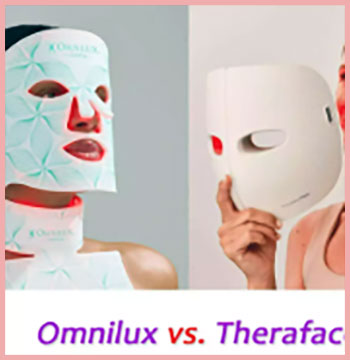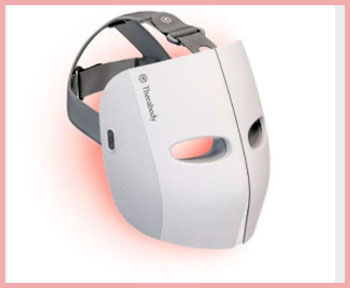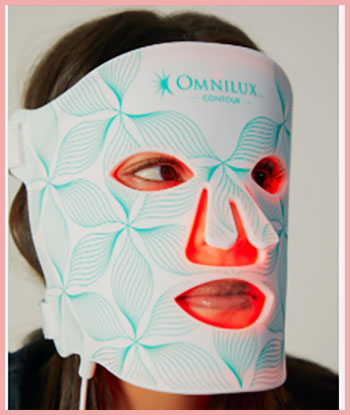
I’m on a quest for radiant, healthy skin, and I’ve been testing two powerhouse LED face masks: the TheraFace by Therabody and the Omnilux Contour Face. My goal? To uncover which device delivers the best results for fine lines, redness, and overall glow. In this article, I’ll share my first-hand experience, break down the pros and cons, and compare their key features to help you decide which mask suits your skincare needs. Let’s explore these high-tech beauty tools together!
Comparison Table: TheraFace vs. Omnilux Contour Face
| Feature | TheraFace Mask | Omnilux Contour Face |
| Price | $599 | $395 |
| LED Count | 648 | 132 |
| Light Modes | Red (630nm), Red + NIR (830nm), Blue (415nm) | Red (633nm), NIR (830nm) |
| Treatment Time | 3-9 minutes, 3-5 times weekly | 10 minutes, 3-5 times weekly |
| Treatment Modes | 4 (Red, Red + NIR, Blue, All-in-One) | 1 (Red + NIR) |
| Vibration Therapy | Yes | No |
| Weight | 1.2 lbs (19.2 oz) | 12.05 oz |
| Material | Hard plastic | Flexible silicone |
| Wireless | Yes | Yes (with controller) |
| Battery Life | ~1 hour | ~3 hours |
| Warranty | 1 year | 2 years |
| FDA Status | FDA-cleared | FDA-cleared |
Why I Chose to Test These LED Masks
Skincare has always been my sanctuary, a way to unwind and invest in myself. But as I hit my late 30s, I noticed fine lines creeping around my eyes and persistent redness on my cheeks. I’d heard LED face masks could work wonders, penetrating deeper than creams to boost collagen and calm inflammation.
After researching, I zeroed in on the TheraFace Mask and Omnilux Contour Face—two heavyweights in at-home LED therapy. Both promise smoother, brighter skin, but their approaches differ. I used each for six weeks to see which lived up to the hype.
My Experience with the TheraFace Mask
The TheraFace Mask, from Therabody (the folks behind the Theragun), arrived looking like a sleek sci-fi helmet. Its hard plastic shell and hefty 1.2-pound weight made it feel substantial, almost like a professional-grade tool. I was excited about its 648 LEDs—way more than most masks—and its three light modes: red (630nm) for anti-aging, red plus near-infrared (830nm) for deeper repair, and blue (415nm) for acne. It also has vibration therapy, which Therabody claims boosts circulation and relaxes facial muscles.
Getting Started
Setting up was a breeze. The mask is cordless, with a USB-C charger, and comes with comfy eye shields to protect against blue light. I started with the nine-minute “all-in-one” mode, which cycles through red, red plus NIR, and blue light. Lying down was more comfortable due to the mask’s weight, but I could walk around if needed. The vibration felt like a gentle massage, especially around my temples, making the experience oddly relaxing.
Results After Six Weeks
By week three, I noticed my skin looked brighter and less splotchy. A stubborn zit on my chin calmed down faster than usual, likely thanks to the blue light zapping acne-causing bacteria. By week six, my forehead lines seemed softer, and my complexion had a subtle glow. The vibration therapy? I’m not sold it did much for my skin, but it made treatments feel spa-like. My husband even commented that my face looked “less tired,” which I’ll take as a win!
Pros of the TheraFace Mask

- Versatile Light Modes: Three wavelengths tackle multiple concerns—wrinkles, dark spots, and acne—in one device.
- High LED Count: 648 LEDs ensure thorough coverage, delivering a potent dose of light (11.7J-14.4J/cm²).
- Vibration Therapy: Adds a relaxing, spa-like touch, potentially aiding circulation.
- Cordless Design: Freedom to move during treatments, though the weight limits comfort when upright.
- Quick Treatments: Options range from 3 to 9 minutes, fitting busy schedules.
Cons of the TheraFace Mask
- Pricey: At $599, it’s a significant investment compared to other LED masks.
- Heavy: The 1.2-pound mask feels cumbersome, especially when lying down.
- Short Battery Life: About an hour, requiring frequent charging if used daily.
- Vibration Noise: The buzzing can be distracting if you’re sensitive to sound.
- One-Year Warranty: Shorter than Omnilux’s two-year coverage.
My Experience with the Omnilux Contour Face
The Omnilux Contour Face felt like a breath of fresh air after the TheraFace’s bulk. Its flexible silicone design hugged my face like a second skin, weighing just 12.05 ounces. With 132 LEDs delivering red (633nm) and near-infrared (830nm) light, it’s built for anti-aging and skin repair, not acne. Omnilux boasts over 40 clinical studies, and dermatologists rave about its medical-grade tech, which gave me high hopes.
Getting Started
The setup was simple but less intuitive than TheraFace. You charge a palm-sized controller, connect it to the mask, and press “on” for a 10-minute session. The Velcro straps were finicky to adjust, and the controller’s cord tugged slightly during use. Still, the mask’s lightweight, flexible fit made it comfy for lounging or even reading in bed. I used it after cleansing, three times a week, as recommended.
Results After Six Weeks
Around week four, my skin felt plumper and looked more even-toned. The redness around my nose and cheeks faded noticeably, and my aesthetician commented on my improved texture during a facial. By week six, my smile lines were less pronounced, and my complexion had a dewy glow. The results were subtle but cumulative, requiring patience. Unlike TheraFace, there’s no blue light, so it didn’t help with occasional breakouts, but it excelled at calming inflammation.
Pros of the Omnilux Contour Face

- Lightweight and Flexible: The silicone design is comfy and molds to your face for even light distribution.
- Clinically Backed: Over 40 studies support its efficacy for wrinkles, redness, and texture.
- Long Battery Life: Up to three hours, outlasting TheraFace’s one-hour charge.
- Two-Year Warranty: Offers peace of mind for a $395 investment.
- Dermatologist Favorite: Trusted by pros for its medical-grade LEDs and results.
Cons of the Omnilux Contour Face
- Single Light Mode: Only red and NIR, so no acne-fighting blue light.
- Fiddly Straps: Thin Velcro straps are tricky to adjust and secure.
- Longer Treatment Time: 10 minutes per session feels less flexible than TheraFace’s options.
- Corded Controller: The tethered controller limits mobility compared to TheraFace’s cordless design.
- Fewer LEDs: 132 LEDs deliver less coverage than TheraFace’s 648.
Head-to-Head: Key Features and Performance
Both masks are FDA-cleared, safe for all skin types, and designed for consistent use (3-5 times weekly). But their features cater to different needs. Here’s how they stack up:
Light Technology and Coverage
TheraFace’s 648 LEDs dwarf Omnilux’s 132, offering broader coverage and a higher energy dose (11.7J-14.4J/cm² vs. Omnilux’s ~30mW/cm²). This makes TheraFace feel like a powerhouse, especially for acne and dark spots. Its blue light (415nm) is a game-changer for breakouts, while Omnilux skips this wavelength, focusing solely on anti-aging with red (633nm) and NIR (830nm). If you’re battling multiple concerns, TheraFace’s versatility wins. For pure anti-aging, Omnilux’s targeted approach holds strong, backed by clinical rigor.
Comfort and Design
Omnilux’s flexible silicone is a dream for comfort, molding to my face without pressure points. I could wear it for 10 minutes without noticing it. TheraFace’s hard plastic, while sturdy, felt heavy and less forgiving, especially when lying down. Its padded strap and eye shields help, but Omnilux’s lightweight design is superior for extended use. If you prioritize portability, Omnilux’s flat storage is a bonus; TheraFace’s bulky box takes up more space.
Treatment Experience
TheraFace offers four modes: three-minute targeted sessions (red, red + NIR, or blue) or a nine-minute all-in-one cycle. This flexibility suits my hectic schedule. Omnilux’s single 10-minute session is straightforward but less customizable. TheraFace’s vibration adds a spa vibe, though it’s noisy. Omnilux’s silent operation is better for quiet relaxation. Both require consistency, but TheraFace’s shorter options felt easier to stick with.
Price and Value
At $599, TheraFace is a splurge, nearly $200 pricier than Omnilux’s $395. TheraFace justifies this with more LEDs, blue light, and vibration, but Omnilux’s clinical pedigree and longer warranty offer strong value. If budget’s a factor, Omnilux delivers professional-grade results for less. For those wanting a multi-tasking device, TheraFace’s higher cost may be worth it.
Which Mask Fits Your Lifestyle?
Choosing between TheraFace and Omnilux depends on your skin goals and routine. Here’s my take:
- Pick TheraFace if: You want a versatile mask for acne, wrinkles, and dark spots. Its blue light and high LED count make it ideal for multiple concerns. You’re okay with a heavier device and shorter battery life for the sake of quick, customizable treatments.
- Pick Omnilux if: You’re focused on anti-aging and redness. Its lightweight, clinically backed design is perfect for consistent use and subtle, long-term results. You don’t mind a single light mode and prefer a lower price point.
I leaned toward Omnilux for its comfort and dermatologist trust, but TheraFace’s acne-fighting blue light was a close contender when breakouts flared. Both improved my skin, but Omnilux felt more seamless in my nightly routine.
Frequently Asked Questions (FAQ)
Yes, if you want a multi-tasking device for acne, wrinkles, and texture. Its $599 price is steep, but 648 LEDs and blue light deliver versatile results.
Absolutely. Omnilux is a dermatologist favorite, backed by over 40 clinical studies for reducing wrinkles and redness.
Kim Kardashian has endorsed the CurrentBody LED Mask Series 2, not TheraFace or Omnilux, for its red and NIR wavelengths.
Omnilux is better for full-face anti-aging with medical-grade LEDs. Solawave’s wand is ideal for targeted treatments but covers less area.
Also Read: Clarins vs. Kiehls
Final Thoughts: Your Path to Radiant Skin
After six weeks with both masks, I’m thrilled with my smoother, brighter skin. TheraFace’s versatility tackled my occasional acne and fine lines, while Omnilux’s lightweight design and clinical backing calmed my redness like a pro. Your choice depends on what you need: TheraFace for multi-concern flexibility or Omnilux for anti-aging precision. Whichever you pick, consistency is key. Invest in one of these masks, stick with it, and you’ll see your skin transform. Let me know which you choose—I’d love to hear about your glow-up journey!
